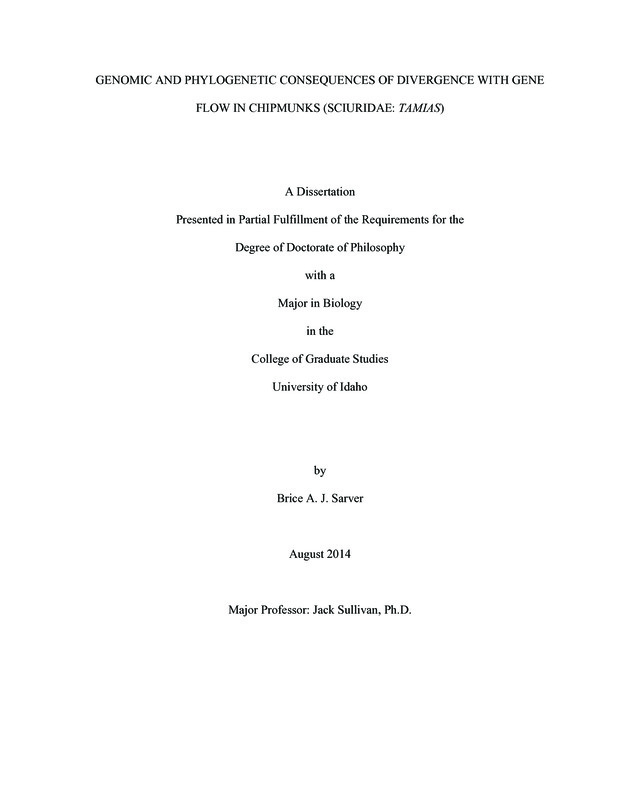Genomic and Phylogenetic Consequences of Divergence with Gene Flow in Chipmunks (Sciuridae: Tamias)
Sarver, Brice Andrew James. (2014). Genomic and Phylogenetic Consequences of Divergence with Gene Flow in Chipmunks (Sciuridae: Tamias). Theses and Dissertations Collection, University of Idaho Library Digital Collections. https://www.lib.uidaho.edu/digital/etd/items/sarver_idaho_0089e_10384.html
- Title:
- Genomic and Phylogenetic Consequences of Divergence with Gene Flow in Chipmunks (Sciuridae: Tamias)
- Author:
- Sarver, Brice Andrew James
- Date:
- 2014
- Keywords:
- chipmunks evolution genomics mitochondria phylogenetics
- Program:
- Biology
- Subject Category:
- Biology; Systematic biology; Genetics
- Abstract:
-
Speciation, the means through which new species arise, is of central interest to biology. Recent theoretical, methodological, and computational advances have allowed researchers to study speciation at scales that were once impossible. This dissertation builds on existing literature to arrive at conclusions regarding the estimation of diversification rates from molecular phylogenies and characterize nuclear and mitochondrial genetic patterns in western North American chipmunks (
Tamias , subgenusNeotamias ), a system that has experienced rapid diversification in the face of gene flow.Rates of diversification and extinction can be inferred from phylogenies using a series of statistical approaches. However, parameter estimates should be affected by errors introduced during phylogenetic estimation. I conducted a simulation study to assess the impact of molecular clocks and tree priors on the estimates of diversification rates. I found that the choice of molecular clock and choice of tree prior do not impact estimates of diversification rates except in circumstances of extreme mismatch (e.g., assuming a single-rate clock when extreme rate heterogeneity is present).
Previous work describes widespread mitochondrial introgression in chipmunks. To generate data sufficient to characterize evolutionary patterns in central and southern Rocky Mountains chipmunks, I use an exon capture technique to sequence thousands of loci from 51 individuals across 6 species of chipmunks. I assemble and characterize mitochondrial genomes from all individuals. Phylogenetic analyses indicated rampant mitochondrial introgression; subsequent tests suggest that selection at protein-coding genes does not appear to be governing introgression. I conclude that demographic factors, such as population expansion, provide a likely explanation of the patterns of introgression in these species.
I conducted a nuclear phylogenomic analysis, using data from thousands of nuclear loci and resolved the relationships among the six species using a mix of traditional and species-tree estimation approaches. I characterized the genomics of this system using several population genetic approaches and find little nuclear introgression, suggesting that the nuclear genome is resistant to introgression in the face of widespread mitochondrial introgression. I conducted these analyses in the absence of a reference genome and provide pipelines and suggestions for genomic inferences in non-model systems.
- Description:
- doctoral, Ph.D., Biology -- University of Idaho - College of Graduate Studies, 2014
- Major Professor:
- Sullivan, Jack
- Committee:
- Harmon, Luke J; Hohenlohe, Paul A; Tank, David C
- Defense Date:
- 2014
- Identifier:
- Sarver_idaho_0089E_10384
- Type:
- Text
- Format Original:
- Format:
- application/pdf
- Rights:
- In Copyright - Educational Use Permitted. For more information, please contact University of Idaho Library Special Collections and Archives Department at libspec@uidaho.edu.
- Standardized Rights:
- http://rightsstatements.org/vocab/InC-EDU/1.0/

